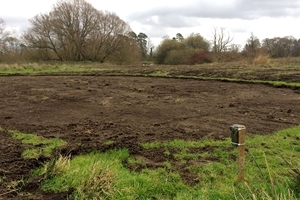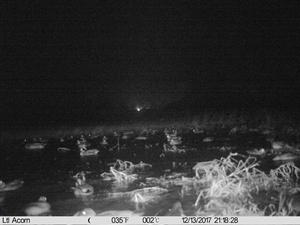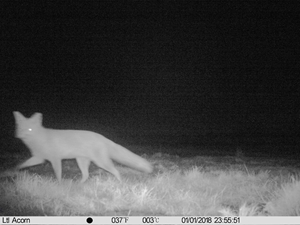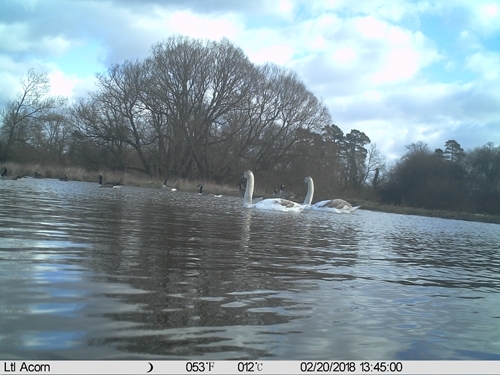By Ellie Ness, Wetlands Placement Student
Back in the autumn, new habitat features were created at Ellingham, a site on the Somerley Estate in the Avon River Valley. This was made possible by funding from the Tarmac Landfill Communities Fund. The site is one of the ones that the GWCT already monitors and works with through the EU LIFE Waders for Real project, and these new features will add to the work already done to create suitable habitats for a wide range of species, with particular focus on the breeding waders and wildfowl.
The work included the installation of a new oxbow lake at the site of a historic one that had filled in over time. New scrapes were also created around the site, and some areas of trees (mainly alders and willow scrub) were cut down and cleared to open up the landscape, remove predator perches and to make it more attractive to breeding waders.

Before and after images of the oxbow lake created.
The features were created with a variety of species in mind. The oxbow will provide a safe place for roach to spawn, as well as being a good habitat for water voles and otters. The scrapes will be great for waders like lapwing to feed in, and they’ll be a safe place for them to bring their chicks down to feed in the breeding season; they are also perfect for wildfowl such as wintering ducks like teal and wigeon, and for the swans and geese.
 After the work finished in the late autumn, trail cameras were set up around the site to monitor the use of these new features by the wildlife in the area. Ten cameras have been set up constantly at the site since December, with specific focus on the new habitat features. They take pictures that are triggered by any movement in front of the camera and can take pictures all through the day and night.
After the work finished in the late autumn, trail cameras were set up around the site to monitor the use of these new features by the wildlife in the area. Ten cameras have been set up constantly at the site since December, with specific focus on the new habitat features. They take pictures that are triggered by any movement in front of the camera and can take pictures all through the day and night.
It didn’t take long for the wildlife to find the new features! Within weeks, the scrapes filled up with water from all the rain we had, and the wildfowl quickly found them. Every night, a large flock of teal used the scrapes, mixed in with the occasional mallard and a few wigeon too. The scrapes also constantly have swans and geese using them (so far, Canada, greylag and Egyptian geese have been seen).
Wintering sandpipers are seen regularly using the scrapes on the camera trap pictures, and always fly off from them every time the cameras are checked, showing that the wading birds have already found it and it’s a perfect habitat for them to feed in. Lots of snipe were using the edges of the scrapes to feed too and were seen every time the cameras were checked.
Also, on the camera trap pictures, the occasional otter has been picked up, along with regular fox sightings from both the cameras by the scrapes and on the oxbow lake. A range of other species have also been seen, including roe deer, cormorants, gulls, egrets, herons and corvids.


Left: A large flock of teal using a scrape at night. Right: A fox walking past one of the new scrape features.
 Swans and geese on a new scrape.
Swans and geese on a new scrape.
Now we are coming into spring, the mammals will become more active and monitoring for water voles can start. The site will be surveyed regularly to look for any signs of water vole activity along the oxbow lake and the river running through the site. We’ll be looking for sightings of the voles themselves, burrows, droppings, footprints, or areas that they’ve been feeding in. Surveying for roach in the oxbow will start in the coming months too.
As the weather warms up, we should see even more species using these features, such as dragonflies, damselflies and other invertebrates. Hopefully breeding wildfowl and waders (such as gadwall and lapwing) will make use of the opportunities for nesting and feeding that these changes in the landscape will provide.